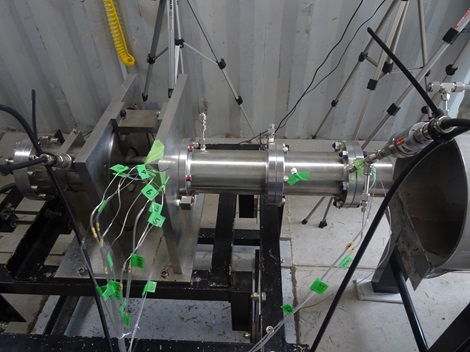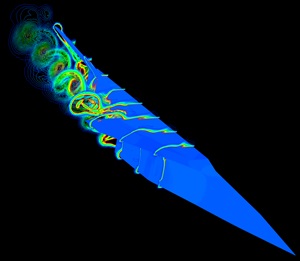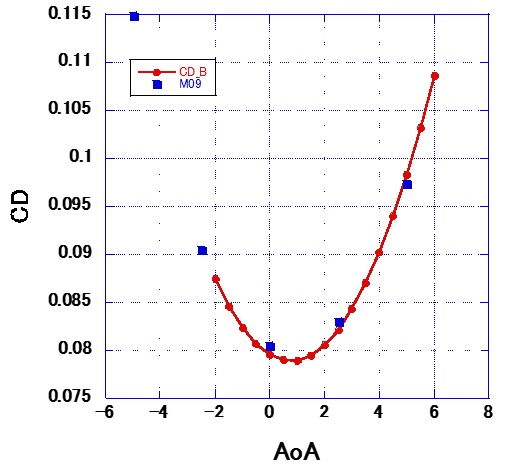Research on future space transportation technology
JAXA Supercomputer System Annual Report April 2018-March 2019
Report Number: R18EG3103
Subject Category: Research and Development
- Responsible Representative: Susumu Hasegawa, Research Unit IV,Research and Development Directorate , JAXA
- Contact Information: Susumu Hasegawa, Research Unit IV,Research and Development Directorate , JAXA(hasegawa.susumu@jaxa.jp)
- Members: Susumu Hasegawa, Toshihiko Munakata, Masaharu Takahashi , Masaaki Fukui
Abstract
Mainly two topics, aiming at the development of the space transport system in the future are studied.
Assuming the flight demonstration, the ejector design that maximizes the air suction performance is examined. Numerical computations are conducted to search for designs that increase combustion pressure while maintaining suction performance and the experiments are conducted in joint research with Tokai University and Chubu University.
Experiments will be conducted in the ISAS / JAXA wind tunnel taking into consideration the effects of spaceplane engine thrust generation and interaction with the airframe, and analysis of longitudinal aerodynamic characteristics and analysis of stability will be conducted jointly with Muroran Institute of Technology and Chubu University.
Reference URL
N/A
Reasons for using JSS2
Ejector design techniques require the computation of the combustible gases resulting from the combustion of hybrid rockets. In the computation of the combustion, it is necessary to perform a large-scale numerical computation because it is essential to calculate many chemical species. In addition, since the number of combustion tests of hybrid rocket is limited, optimization is required for the design of the ejector configuration by performing CFD, which requires large-scale computation.
Furthermore, regarding aerodynamic characteristics of spaceplane which mounted airbreathing engine, it is required to obtain aerodynamic characteristics parametrically by several spaceplane configurations, and large-scale calculation is essential. For the above reasons, the use of the super computer system JSS2 is required for the success of the present research program.
Achievements of the Year
The goal is to establish ejector jet technology in use of the unburned fuel of the hybrid rocket engine. As preparation for the experiments planned at Tokai University, to improve the suction performance, the test results of last year were analyzed by CFD. In the last year’s model, it was found that Fabri choking has occurred, which hinders the improvement of suction performance. In this year, the design of the new ejector is devised to avoid it and confirmed that the suction performance reaches the maximum amount of air in our experiments (Fig.1-2).
Wind tunnel tests at ISAS/JAXA were conducted in consideration of the effects of engine thrust generation and the interaction with the airframe to analyze longitudinal aerodynamic characteristics and stability. Although the analysis of the test results of last year was carried out, in the case of no gas injection from the engine, the agreement between the experiment and the computation is good. However, in the case of gas injection, it is considered that there is an influence of the hose which supply the nitrogen because the deviation is multiplied. Furthermore, in this fiscal year, transonic tests were conducted when the steering angle was changed, and the phenomena were clarified by CFD (Fig.3-4).
Publications
– Peer-reviewed papers
Susumu Hasegawa, et al.,”Preliminary Numerical Simulation of Flow around Spaceplane for Airframe Engine Integration,” “Transactions of JSASS, Aerospace Technology Japan,” Online ISSN : 1884-0485, ISSN-L : 1884-0485
– Non peer-reviewed papers
1)Susumu Hasegawa, “Studies of the configurations for improvement of the annular ejector performance,” the 50th Fluid Dynamics Conference/the 36th Aerospace Numerical Simulation Symposium, Miyazaki, July, 2018.
2) Yoshimasa Nishimura, et al. “Aerodynamic Characteristics of a Rocket-based Combined Cycle Spaceplane,” the 16 th HASTIC Technology Conference,. Sapporo, March, 2019.
3)Susumu Hasegawa, et al., “Flow Analysis around Spaceplane for Airframe Engine Integration by CFD” to be presented at ISTS 2019, Fukui, Japan.
4) Yoshimasa Nishimura, et al., “Aerodynamic Characteristics of a Rocket-based Combined Cycle Spaceplane” to be presented at ISTS 2019, Fukui, Japan.
– Oral Presentations
1)Susumu Hasegawa, “Studies of the configurations for improvement of the annular ejector performance,” the 50th Fluid Dynamics Conference/the 36th Aerospace Numerical Simulation Symposium, Miyazaki, July, 2018.
2) Yoshimasa Nishimura, et al. “Aerodynamic Characteristics of a Rocket-based Combined Cycle Spaceplane,” the 16 th HASTIC Technology Conference,. Sapporo, March, 2019.
3)Susumu Hasegawa, et al., “Flow Analysis around Spaceplane for Airframe Engine Integration by CFD” to be presented at ISTS 2019, Fukui, Japan.
4) Yoshimasa Nishimura, et al., “Aerodynamic Characteristics of a Rocket-based Combined Cycle Spaceplane” to be presented at ISTS 2019, Fukui, Japan.
– Other
Patent application for “invention of ejector device”
Usage of JSS2
Computational Information
- Process Parallelization Methods: MPI
- Thread Parallelization Methods: OpenMP
- Number of Processes: 36 – 256
- Elapsed Time per Case: 500 Hour(s)
Resources Used
Fraction of Usage in Total Resources*1(%): 0.08
Details
Please refer to System Configuration of JSS2 for the system configuration and major specifications of JSS2.
| System Name | Amount of Core Time(core x hours) | Fraction of Usage*2(%) |
|---|---|---|
| SORA-MA | 226,677.16 | 0.03 |
| SORA-PP | 91,465.31 | 0.73 |
| SORA-LM | 0.00 | 0.00 |
| SORA-TPP | 0.00 | 0.00 |
| File System Name | Storage Assigned(GiB) | Fraction of Usage*2(%) |
|---|---|---|
| /home | 2.67 | 0.00 |
| /data | 3,125.00 | 0.06 |
| /ltmp | 390.63 | 0.03 |
| Archiver Name | Storage Used(TiB) | Fraction of Usage*2(%) |
|---|---|---|
| J-SPACE | 0.40 | 0.01 |
*1: Fraction of Usage in Total Resources: Weighted average of three resource types (Computing, File System, and Archiver).
*2: Fraction of Usage:Percentage of usage relative to each resource used in one year.
JAXA Supercomputer System Annual Report April 2018-March 2019






